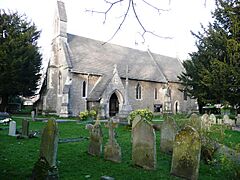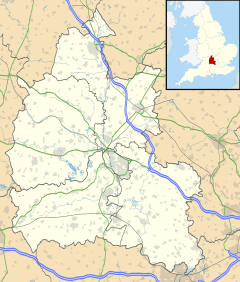Headington Quarry facts for kids
Quick facts for kids Headington Quarry
|
|
|---|---|
 Holy Trinity Church, Headington Quarry |
|
| OS grid reference | SP553070 |
| Civil parish |
|
| District | |
| Shire county | |
| Region | |
| Country | England |
| Sovereign state | United Kingdom |
| Post town | Oxford |
| Postcode district | OX3 |
| Dialling code | 01865 |
| Police | Thames Valley |
| Fire | Oxfordshire |
| Ambulance | South Central |
| EU Parliament | South East England |
| UK Parliament | |
Headington Quarry is a village about 2.5 miles (4 km) east of Oxford, England. It's located just inside the Oxford Ring Road. You can find it close to Headington, Wood Farm, and Risinghurst.
Today, people often call the village simply "Quarry." The land here is quite uneven because of all the quarrying (digging for stone) that happened in the past.
Contents
The Famous Morris Dancers
The Headington Quarry Morris Dancers are a well-known group from this area. They perform a traditional English folk dance. A famous person named Cecil Sharp first saw Morris dancers here on Boxing Day in 1899. This meeting made him very interested in folk dance, songs, and music. He spent much of his life studying and preserving these traditions.
Protecting the Area
Headington Quarry was made a special "conservation area" in 1971. This means its unique character and history are protected. A group called the Friends of Quarry works to keep the area special. They help preserve its distinctive look and feel for everyone to enjoy.
A Look Back in Time
The Headington Quarry Church of England First School was built in 1864. It closed in 2003 and was replaced by a new school. The old school building is now a listed building, which means it's historically important and protected.
A very clever mathematician named Joan Clarke lived in Headington Quarry. She worked as a code-breaker during World War II at Bletchley Park. She was also a colleague and briefly engaged to Alan Turing, another famous code-breaker. Joan lived here from 1991 until she passed away in 1996. In 2019, a special blue plaque was put on her former home to remember her.
The Local Church
Holy Trinity Church is the main church in the village. It was designed by a famous architect, George Gilbert Scott, and built in the late 1840s. One of its beautiful windows was designed by Ninian Comper. A group called the Friends of Holy Trinity Church helps raise money and care for the church.
The famous author C. S. Lewis, who wrote The Chronicles of Narnia, attended Holy Trinity Church. He is also buried in the churchyard. There is also an old Methodist Chapel on Quarry High Street.
Special Stone from Headington
Headington Quarry used to have many stone quarries. The stone found here, called Headington stone, is a type of limestone. This stone was often used to build some of the old college buildings at Oxford University. However, it could wear away easily from pollution.
For example, in 1396, Headington stone was used to build the bell-tower for New College. It was also used for the foundations and walls of All Souls College in the early 1400s. Later, in the 1520s, Cardinal Wolsey used this stone to build his big college, which is now known as Christ Church.


